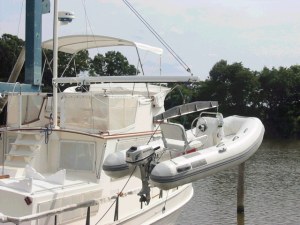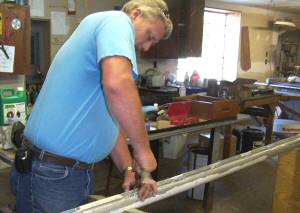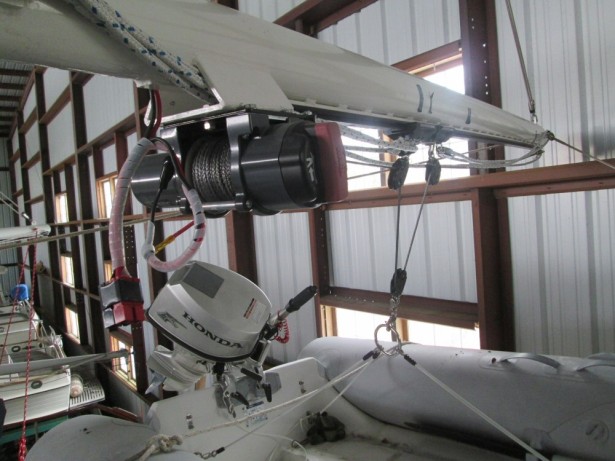
Having a dinghy aboard can be a luxury, a convenience or even a lifesaver. But the hard part is getting it on and off the boat. Years ago we devised a way to use the gear you already have on board to take care of the hard part.
Almost every Grand Banks already has a mast and boom, which give it that “trawler look”. Hardly anyone uses it for anything other than an antenna extender, although I have seen a couple that actually use a steadying sail on the mast. Since the mast is already there, “beefy enough” and available, we decided to use that for the dinghy lift system.
Most people don’t realize the engineering that goes into this job. The major hurdle is the strength of the boom and the track. We did the calculations to determine the right reinforcements to use and are using track that will work properly. Since the track is actually upside down with all the weight suspended from it, it is important to spec this out to allow for the weight of the dingy, the motor and fuel and any other weight that will be in the dinghy. In the photo above, we had to allow for a whole center console in the dinghy, making this the most heavy rig to date!

The mechanics are fairly straightforward. We use a marinized winch which is specially made for us and has a stainless steel drum. We also replace the cable that comes with the drum with 7×19 SS cable. The hardest part of the electrical side is getting the cable to the breaker panel. If the panel is full, we usually find a compatible piece of equipment, such as a windlass, that will not be drawing power at the same time as your boom lift. The control is very simple as it is built right into the motor so remote switch wiring is not needed.
Our calculations tell us the right amount of reinforcement we need on the boom. This stiffener is welded on to the boom to strengthen it even more. After this step, the whole boom will need to be painted to make sure it has a factory look. We coat the bare metal first with an alodine to inhibit any future corrosion. Afterwards, a fresh coat of Awlgrip does the trick.
Installing the track is the most time consuming part of the job. Every hole needs to be predrilled and tapped to attach the track. Usually the holes are spaced about 3-4′ apart, so on a track 10′ long you can see that that would be a lot of time.
After the boom is rigged up, it is time to tackle the tackle for the dinghy lifting harness. A bit of physics does come in handy here to ensure the dinghy raises and lowers on a level plane. We install eye pads in the dingy and fabricate a harness out of stainless cable and fittings.
We often do “boom jobs by mail” but since we do not have access to your boat, they obviously do not include any of the wiring or the dinghy harness. Contact us if you would like more information.

 Having a dinghy aboard can be a luxury, a convenience or even a lifesaver. But the hard part is getting it on and off the boat. Years ago we devised a way to use the gear you already have on board to take care of the hard part.Almost every Grand Banks already has a mast and boom, which give it that “trawler look”. Hardly anyone uses it for anything other than an antenna extender, although I have seen a couple that actually use a steadying sail on the mast. Since the mast is already there, “beefy enough” and available, we decided to use that for the dinghy lift system.
Most people don’t realize the engineering that goes into this job. The major hurdle is the strength of the boom and the track. We did the calculations to determine the right reinforcements to use and are using track that will work properly. Since the track is actually upside down with all the weight suspended from it, it is important to spec this out to allow for the weight of the dingy, the motor and fuel and any other weight that will be in the dinghy. In the photo above, we had to allow for a whole center console in the dinghy, making this the most heavy rig to date!
Having a dinghy aboard can be a luxury, a convenience or even a lifesaver. But the hard part is getting it on and off the boat. Years ago we devised a way to use the gear you already have on board to take care of the hard part.Almost every Grand Banks already has a mast and boom, which give it that “trawler look”. Hardly anyone uses it for anything other than an antenna extender, although I have seen a couple that actually use a steadying sail on the mast. Since the mast is already there, “beefy enough” and available, we decided to use that for the dinghy lift system.
Most people don’t realize the engineering that goes into this job. The major hurdle is the strength of the boom and the track. We did the calculations to determine the right reinforcements to use and are using track that will work properly. Since the track is actually upside down with all the weight suspended from it, it is important to spec this out to allow for the weight of the dingy, the motor and fuel and any other weight that will be in the dinghy. In the photo above, we had to allow for a whole center console in the dinghy, making this the most heavy rig to date!
 The mechanics are fairly straightforward. We use a marinized winch which is specially made for us and has a stainless steel drum. We also replace the cable that comes with the drum with 7×19 SS cable. The hardest part of the electrical side is getting the cable to the breaker panel. If the panel is full, we usually find a compatible piece of equipment, such as a windlass, that will not be drawing power at the same time as your boom lift. The control is very simple as it is built right into the motor so remote switch wiring is not needed.
Our calculations tell us the right amount of reinforcement we need on the boom. This stiffener is welded on to the boom to strengthen it even more. After this step, the whole boom will need to be painted to make sure it has a factory look. We coat the bare metal first with an alodine to inhibit any future corrosion. Afterwards, a fresh coat of Awlgrip does the trick.
Installing the track is the most time consuming part of the job. Every hole needs to be predrilled and tapped to attach the track. Usually the holes are spaced about 3-4′ apart, so on a track 10′ long you can see that that would be a lot of time.
After the boom is rigged up, it is time to tackle the tackle for the dinghy lifting harness. A bit of physics does come in handy here to ensure the dinghy raises and lowers on a level plane. We install eye pads in the dingy and fabricate a harness out of stainless cable and fittings.
We often do “boom jobs by mail” but since we do not have access to your boat, they obviously do not include any of the wiring or the dinghy harness. Contact us if you would like more information.
The mechanics are fairly straightforward. We use a marinized winch which is specially made for us and has a stainless steel drum. We also replace the cable that comes with the drum with 7×19 SS cable. The hardest part of the electrical side is getting the cable to the breaker panel. If the panel is full, we usually find a compatible piece of equipment, such as a windlass, that will not be drawing power at the same time as your boom lift. The control is very simple as it is built right into the motor so remote switch wiring is not needed.
Our calculations tell us the right amount of reinforcement we need on the boom. This stiffener is welded on to the boom to strengthen it even more. After this step, the whole boom will need to be painted to make sure it has a factory look. We coat the bare metal first with an alodine to inhibit any future corrosion. Afterwards, a fresh coat of Awlgrip does the trick.
Installing the track is the most time consuming part of the job. Every hole needs to be predrilled and tapped to attach the track. Usually the holes are spaced about 3-4′ apart, so on a track 10′ long you can see that that would be a lot of time.
After the boom is rigged up, it is time to tackle the tackle for the dinghy lifting harness. A bit of physics does come in handy here to ensure the dinghy raises and lowers on a level plane. We install eye pads in the dingy and fabricate a harness out of stainless cable and fittings.
We often do “boom jobs by mail” but since we do not have access to your boat, they obviously do not include any of the wiring or the dinghy harness. Contact us if you would like more information.


